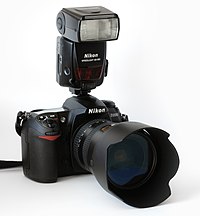Nikon D200
 |
|
| Overview | |
|---|---|
| Type | Digital single-lens reflex |
| Lens | |
| Lens | Interchangeable, Nikon F-mount |
| Sensor/Medium | |
| Sensor | Nikon DX format 23.7 mm × 15.6 mm CCD |
| Maximum resolution | 3,872 × 2,592 (10.2 M/10.0 M pixels sensor/effective) |
| ASA/ISO range | 100 - 1600 in 1, 1/2 or 1/3 EV steps (up to 3200 as boost) |
| Recording medium | CompactFlash (Type I or Type II) or Hitachi Microdrive |
| Focusing | |
| Focus modes | Instant single-servo AF (S), continuous-servo AF (C), manual (M) |
| Focus areas | Normal: 11 areas; Wide: focus area can be selected from 7 areas |
| Exposure/Metering | |
| Exposure modes | Programmed Auto [P] with flexible program; Shutter-Priority Auto [S]; Aperture Priority Auto [A]; Manual [M] |
| Exposure metering | Three-mode through-the-lens (TTL) exposure metering |
| Metering modes | 3D Color Matrix Metering II, Center-weighted and Spot |
| Flash | |
| Flash | Manual pop-up with button release Guide number (ISO 100, m) |
| Flash bracketing | 3 to +1 EV in increments of 1/3 or 1/2 EV |
| Shutter | |
| Shutter | Electronically controlled vertical-travel focal plane shutter |
| Shutter speed range | 30 s – 1/8000 s, bulb |
| Continuous shooting | 5 frame/s, up to 37 / 22 frames (JPEG / RAW) |
| Viewfinder | |
| Viewfinder | Optical |
| Image Processing | |
| Custom WB | Auto, Six presets, Manual preset (four), Kelvin temperature, Fine tunable |
| WB bracketing | 2 to 9 frames in increments of 1, 2 or 3 |
| General | |
| Rear LCD monitor | 2.5-inch (63.5 mm) TFT LCD, 230,000 pixels |
| Battery | Nikon EN-EL3e Lithium-Ion battery |
| Optional battery packs | MB-D200 battery pack with one or two Nikon EN-EL3e or six AA batteries |
| Weight | About 830 g without battery, memory card, body cap, or monitor cover |
| Made in | Thailand |
The Nikon D200 is a 10.2-megapixel digital single-lens reflex camera that falls between entry-level/midrange DSLR cameras such as the Nikon D40, Nikon D40x, and D80 and high-end models such as the Nikon D2Hs and D2Xs. It was released by the Nikon Corporation in November 2005. The D200 was succeeded by the D300 in August 2007.
Main advantages over the D40, D40x, D50, D60 and D80 cameras include:
Compared with Nikon's professional cameras, mainly the D2Xs, the D200 lacks an integrated vertical battery grip, longer battery life, and some minor features. The autofocus system has only one cross-type sensor instead of nine like the D2H, D2Hs, D2X and D2Xs, though it has the same number of focus points (eleven). This means the D200 has the versatility but lacks the precision of the D2 series, particularly with the sensors other than the center cross-type sensor, and in low-light conditions. The D200 offers a lower price and a more compact, lighter body than the D2 series.
The main competitor for the D200 was the Canon EOS 30D, which had many of the same features. The D200 was also often compared with the Canon EOS 5D, but these two cameras were intended for somewhat different uses – unlike the 30D or 5D, the D200 has weathersealed buttons, allowing it to be used in more demanding outdoor environments.
The Fujifilm S5 Pro is based on the Nikon D200. While both cameras use the same body, the technology used in the imaging systems is different—the Fuji lacks the frame rate and buffer depth of the Nikon, with the Fuji sensor and image processor geared towards higher dynamic range (Fuji Super CCD).
The D200 was announced in November 2005 with an initial estimated selling price of $1699.95 US. Some cameras in initial shipments exhibited "banding" in images. The camera won the TIPA 2006 award for Best Digital SLR in the Expert category.
The D200 is often used as a backup body to supplement the high-end professional line of cameras because of its similar feature-set and control layout. Upon its introduction, it was intended to fill the void in the Nikon line-up left by the discontinuation of the Nikon D100. It is in many ways the professional version of the D80.
...
Wikipedia
